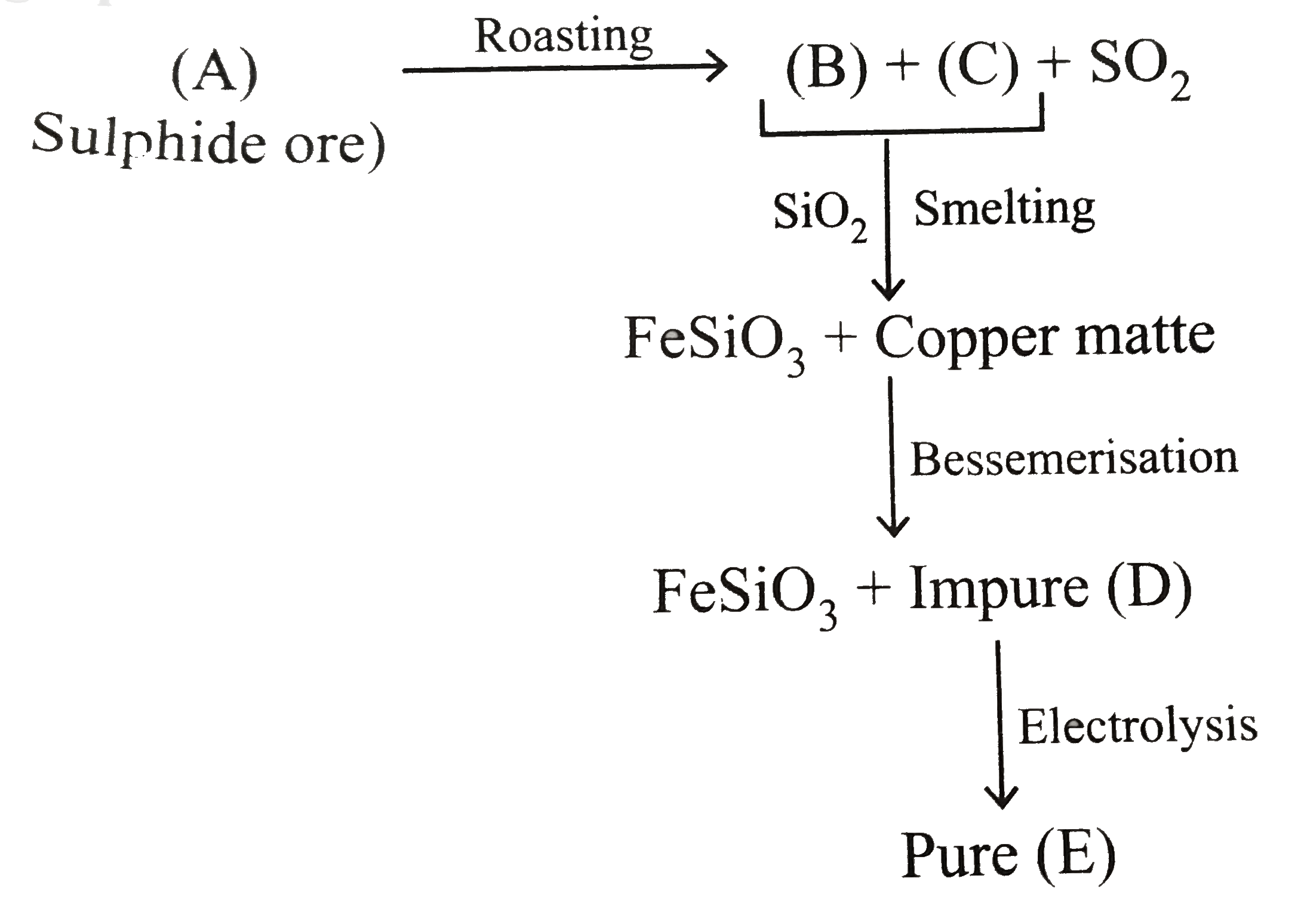Identify A to E and also explain the reaction involved.

The substances from A to E are
A = Cu, B = Cu(NO3)2, C = [Cu(NH3)4]2+, D = CO2, E = CaCO3
Reactions:
(i) CuCO3Δ−−→CuO+CO2×2
(ii) 2CuO+CuS→3Cu[A]+SO2
(iii) Cu[A]+4HNO3(Conc.)→Cu(NO3)2[B]+2NO+2H2O
(iv) Cu2+[B]+NH3→[Cu(NH3)4][C](Blue solution)
(v) Ca(OH)2+CO2[D]→CaCO3[E](Milky)+H2O
(vi) CaCO3+H2O+CO2→Ca(HCO3)2
Topper's Solved these Questions
- D AND F-BLOCK ELEMENTSBOOK - NCERT EXEMPLAR ENGLISHCHAPTER - D AND F-BLOCK ELEMENTSEXERCISE - Short Answer Type Question
20 Videos
- COORDINATION COMPOUNDSBOOK - NCERT EXEMPLAR ENGLISHCHAPTER - COORDINATION COMPOUNDSEXERCISE - Long Answer Type Question
5 Videos
- ELECTROCHEMISTRYBOOK - NCERT EXEMPLAR ENGLISHCHAPTER - ELECTROCHEMISTRYEXERCISE - All Questions
67 Videos
Similar Questions
When an oxide of manganese (A) is fused with KOH in the presence of an oxidising agent and dissolved in water, it gives a dark green solution of compound (B). Compound (B) disproportionates in neutral or acidic (C ) oxidises potassium iodide solution to a compound (D) and compound (A) is also formed. Identify compounds A to D and also explain the reactions involved.
View Solution0.36 g of a bromoderivative of a hydrocarbon (A) when vaporized occupied 65.2 mL at NTP. (A) on reaction with aqueous NaOH gave (B). (B) when passed over alumina at 250∘C, gives a neutral compound (C) while at 350∘C, it gives a hydrocarbon (D). (D) when treated with HBr gave an isomer of(A). When (D) is treated with conc. H2SO4 and the product is diluted with water and distilled, (E) is obtained. Identify from (A) to (E) and explain the reactions involved.
View Solution0.36 g of a bromoderivative of a hydrocarbon (A) when vaporized occupied 65.2 mL at NTP. (A) on reaction with aqueous NaOH gave (B). (B) when passed over alumina at 250∘C, gives a neutral compound (C) while at 350∘C, it gives a hydrocarbon (D). (D) when treated with HBr gave an isomer of(A). When (D) is treated with conc. H2SO4 and the product is diluted with water and distilled, (E) is obtained. Identify from (A) to (E) and explain the reactions involved.
View Solution0.36 g of a bromoderivative of a hydrocarbon (A) when vaporized occupied 65.2 mL at NTP. (A) on reaction with aqueous NaOH gave (B). (B) when passed over alumina at 250∘C, gives a neutral compound (C) while at 350∘C, it gives a hydrocarbon (D). (D) when treated with HBr gave an isomer of(A). When (D) is treated with conc. H2SO4 and the product is diluted with water and distilled, (E) is obtained. Identify from (A) to (E) and explain the reactions involved.
View Solution
What is the reaction involved in B?
View SolutionA substance X, which is an oxide of a group 2 element, is used intensively in the cement industry. This element is present in bones also. On treatment with water it forms a solution which turns red litmus blue. Identify X and also write the chemical reactions involved.
View Solution
Identify (E).
View SolutionMetabolic reaction involves
View SolutionName the reaction which is commonly used in the conversion of vegetable oil to fats. Explain the reaction involved in detail.
View SolutionGive a method for the manufacture of hydrogen peroxide and explain the reactions involved therein .
(ii) Illustrate oxidising, reducing and acidic properties of hydrogen peroxide with equations.
View Solution
